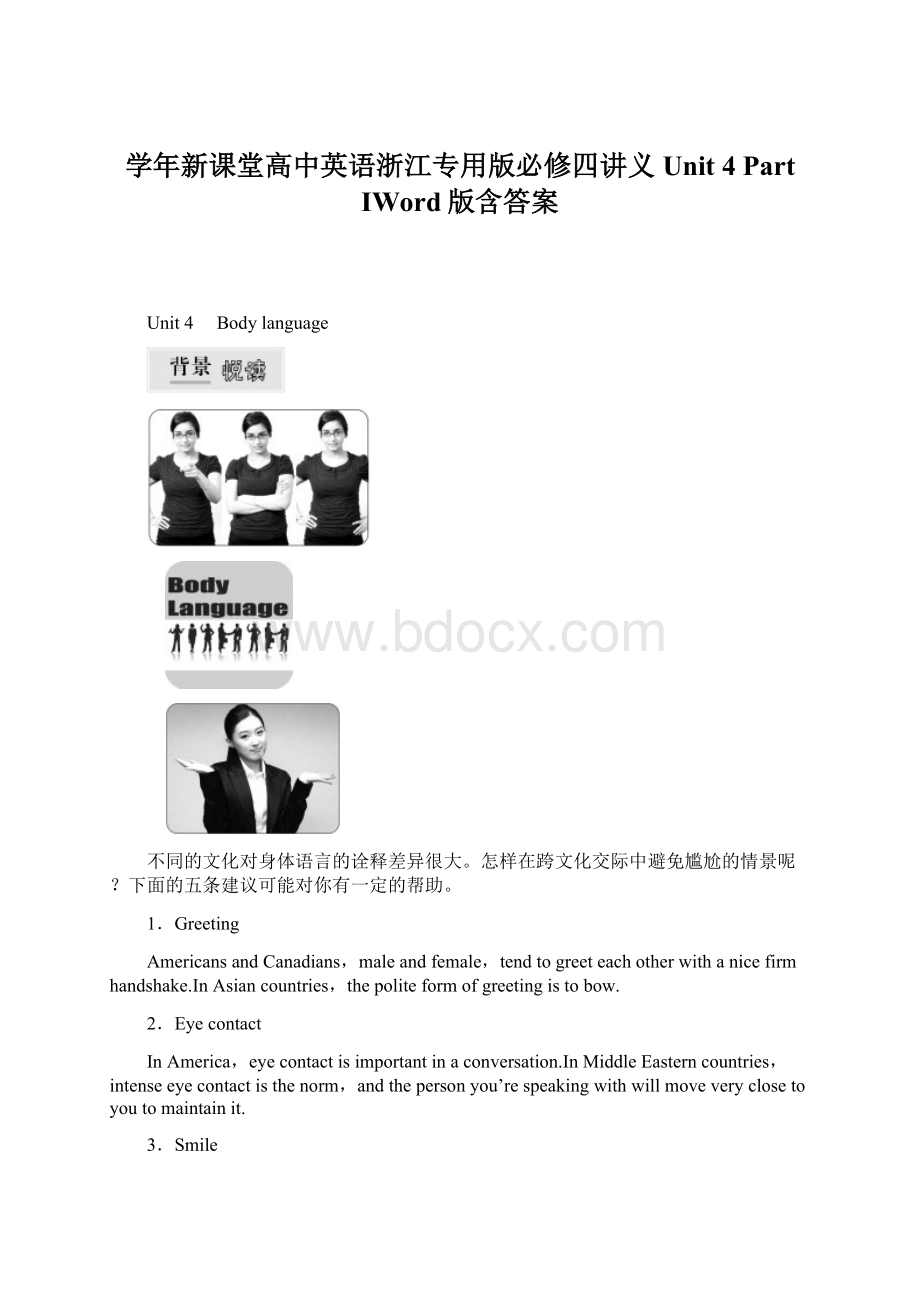学年新课堂高中英语浙江专用版必修四讲义Unit 4 Part ⅠWord版含答案.docx
《学年新课堂高中英语浙江专用版必修四讲义Unit 4 Part ⅠWord版含答案.docx》由会员分享,可在线阅读,更多相关《学年新课堂高中英语浙江专用版必修四讲义Unit 4 Part ⅠWord版含答案.docx(22页珍藏版)》请在冰豆网上搜索。

学年新课堂高中英语浙江专用版必修四讲义Unit4PartⅠWord版含答案
Unit4 Bodylanguage
不同的文化对身体语言的诠释差异很大。
怎样在跨文化交际中避免尴尬的情景呢?
下面的五条建议可能对你有一定的帮助。
1.Greeting
AmericansandCanadians,maleandfemale,tendtogreeteachotherwithanicefirmhandshake.InAsiancountries,thepoliteformofgreetingistobow.
2.Eyecontact
InAmerica,eyecontactisimportantinaconversation.InMiddleEasterncountries,intenseeyecontactisthenorm,andthepersonyou’respeakingwithwillmoveveryclosetoyoutomaintainit.
3.Smile
Americans,ingeneral,smilewhentheymeetorgreetsomeone.Koreans,however,thinkit’srudeforadultstosmileinpublic.
4.Pointing
MostAmericansthinknothingofpointingatanobjectoranotherperson.NativeAmericansconsideritextremelyrudetopointwithafinger.It’salsorudetopointwithafingerinChina.
5.Space
Givetherightamountofspace.InAsiancultures,theconceptofpersonalspaceisnearlynon-existent.Strangersregularlytouchbodieswhenstandinginlineformovietickets.PeopleinScandinaviancountries,ontheotherhand,needmorepersonalspacethanwedo.
词海拾贝
1.tend/tend/vi.倾向(于),趋向(于)
vt.照料,照顾
2.contact/’kɒntækt/n.接触;联系
v.(与)联系;(与)接触
3.ingeneral大体上;一般来说;通常
4.concept/’kɒnsept/n.概念
PartⅠ WarmingUp&Reading
Ⅰ.重点单词
1.greetvi.&vt.迎接;问候
2.representvt.代表;象征
3.flightn.飞行;航班
4.dashvi.猛冲;突进
5.approachvt.&vi.接近;靠近;走近n.接近;方法;途径
6.adultn.成年人;成人adj.成人的;成熟的
7.likelyadj.可能的
8.crossroadsn.十字路口
9.statementn.陈述;说明→statevt.陈述;说明
10.associationn.社团;联系;联想→associatevt.结交;联合
11.curiousadj.好奇的→curiouslyadv.好奇地→curiosityn.好奇心
12.defendvt.保护;保卫→defencen.防御;保卫
13.majoradj.主要的→majorityn.大多数
14.misunderstandvt.误解;误会→misunderstandingn.误解;误会
15.spokenadj.口语的→unspokenadj.未说出口的;非口语的
16.employeen.雇员→employv.雇用;使用→employern.雇主→employmentn.雇用;就业
Ⅱ.核心短语
1.defend__against/from 保卫……以免受
2.in__defence保卫;防御
3.on__the__contrary相反的
4.be__likely__to很可能……;有希望……
5.in__general总的来说;通常
6.closeto靠近
7.inplaceof代替
8.reachout伸出
9.shakehandswith与……握手
Ⅲ.经典句式
1.Yesterday,anotherstudentandI,representing__our__university’sstudentassociation,wenttotheCapitalInternationalAirporttomeetthisyear’sinternationalstudents.昨天我和另一个同学代表我们大学的学生会去首都国际机场迎接今年的国际学生。
2.Thefirstpersonto__arrivewasTonyGarciafromColombia,closely__followedbyJuliaSmithfromBritain.
第一个到达的是从哥伦比亚来的托尼·加西亚,随后紧跟着的是英国的朱莉娅·史密斯。
3.Not__all__culturesgreeteachotherthesameway,nor__are__theycomfortableinthesamewaywithtouchingordistancebetweenpeople.
各种文化背景下人们互致问候的方式不尽相同,身体接触和相互间距离的程度也并不一样。
4.However,peoplefromplaceslikeSpain,ItalyorSouthAmericancountriesapproachotherscloselyandare__more__likely__to__touch__them.
但是,来自像西班牙、意大利或南美等国家的人会站在离别人很近的地方,而且很可能(用身体)接触对方。
5.Theseactionsarenotgoodorbad,butaresimplywaysin__which__cultures__have__developed.
这些行为无所谓好坏,它们只不过是文化发展的不同方式而已。
1.转化词汇
①adultn.成人;成年人→adj.成人的;成熟的
②approachvt.&vi.接近;靠近;走近→n.接近;方法;途径
③majoradj.主要的→n.专业;少校vi.主修
2.派生词汇
►名词后缀:
-ment,-tion,-ence
①statev.陈述;说明→statementn.陈述;说明
②associatev.联想;联合→associationn.社团;联系;联想
③defendvt.保护;保卫→defencen.防御;保卫
►否定前缀:
mis-
understandv.理解→misunderstandvt.误解;误会
3.合成词汇
cross(十字形)+road(道路)→crossroadsn.十字路口
原文呈现
COMMUNICATION:
NOPROBLEM①?
Yesterday,anotherstudentandI,representing②ouruniversity’sstudentassociation③,wenttotheCapitalInternationalAirporttomeetthisyear’sinternationalstudents.TheywerecomingtostudyatBeijingUniversity.Wewouldtakethemfirsttotheirdormitories④andthentothestudentcanteen⑤.Afterhalfanhourofwaitingfortheirflight⑥toarrive,Isawseveralyoungpeopleenterthewaitingarealookingaroundcuriously⑦.Istoodforaminutewatchingthemandthenwenttogreetthem.
ThefirstpersontoarrivewasTonyGarciafromColombia⑧,closelyfollowedbyJuliaSmithfromBritain.AfterImetthemandthenintroducedthemtoeachother,Iwasverysurprised.Tonyapproached⑨Julia,touchedhershoulderandkissedheronthecheek⑩!
Shesteppedbackappearingsurprisedandputupherhands,asifindefence⑪.Iguessedthattherewasprobablyamajor⑫misunderstanding⑬.ThenAkiraNagatafromJapancameinsmiling,togetherwithGeorgeCookfromCanada.Astheywereintroduced,Georgereachedhishandoutto⑭theJapanesestudent.Justatthatmoment,however,AkirabowedsohisnosetouchedGeorge’smovinghand.Theybothapologized—anotherculturalmistake!
AhmedAziz,anotherinternationalstudent,wasfromJordan⑮.Whenwemetyesterday,hemovedveryclosetomeasIintroducedmyself.Imovedbackabit,buthecameclosertoaskaquestionandthenshookmyhand.WhenDarleneCoulonfromFrancecamedashing⑯throughthedoor,sherecognizedTonyGarcia’ssmilingface.Theyshookhands⑰andthenkissedeachothertwiceoneachcheek,sincethatistheFrenchcustomwhenadults⑱meetpeopletheyknow.AhmedAziz,onthecontrary⑲,simply⑳noddedatthegirls.MenfromMiddleEasternandotherMuslim
countrieswilloftenstandquitecloseto
othermentotalkbutwillusuallynottouchwomen.
AsIgettoknow
moreinternationalfriends,Ilearnmoreaboutthiscultural“bodylanguage”.Notall
culturesgreeteachotherthesameway,noraretheycomfortableinthesamewaywithtouchingordistancebetweenpeople.Inthesamewaythatpeoplecommunicatewithspokenlanguage,theyalsoexpresstheirfeelingsusingunspoken“language”throughphysicaldistance,actionsorposture
.Englishpeople,forexample,donotusuallystandveryclosetoothersortouchstrangersassoonastheymeet.However,peoplefromplaceslikeSpain
,Italy
orSouthAmericancountriesapproachotherscloselyandaremorelikelyto
touchthem.Mostpeoplearoundtheworldnowgreeteachotherbyshakinghands,butsomeculturesuseothergreetingsaswell
,suchastheJapanese,whoprefertobow.
Theseactionsarenotgoodorbad,butaresimply
waysinwhichcultureshavedeveloped.Ihaveseen,however,thatculturalcustomsforbodylanguageareverygeneral—notallmembersofaculturebehaveinthesameway.Ingeneral
,though
,studyinginternationalcustomscancertainlyhelpavoiddifficultiesintoday’sworldofculturalcrossroads
!
阅读清障
①noproblem用来回答别人的道歉或致谢,意为“没什么,不客气,没关系”;若表示乐于相助或事情容易做到,则意为“没问题”。
②represent/,reprI’zent/vt.代表;象征
③association/ə,səʊsI’eIʃn/n.社团;联系
※现在分词短语作定语,前后有逗号隔开时,相当于一个非限制性定语从句。
④dormitory/’dɔ:
mItrI/n.宿舍
⑤canteen/kæn’ti:
n/n.食堂
⑥flight/flaIt/n.飞行;航班
⑦curiously/’kjʊərIəslI/adv.好奇地
curious/’kjʊərIəs/adj.好奇的
※现在分词短语作伴随状语。
※动词不定式toarrive作定语,被修饰词thefirstperson与它是主动关系。
⑧Colombia/kə’lʌmbIə/n.哥伦比亚(南美洲国家)
※过去分词短语作定语,相当于非限制性定语从句whowascloselyfollowed...。
⑨approach/ə’prəʊtʃ/vt.&vi.接近;靠近;走近n.接近;方法;途径
⑩kisssb.onthecheek亲吻某人的脸颊
cheek/tʃi:
k/n.面颊
※现在分词短语作伴随状语。
⑪indefence(of)保护;为了保卫;(为……)辩护
defence/dI’fens/n.防御;保卫
defend//dI’fend/vt.保护;保卫
⑫major/’meIdʒə/adj.主要的;重要的
⑬misunderstandingn.误解;误会
misunderstand/,mIsʌndə’stænd/vt.误解;误会
⑭reachone’shandouttosb.向某人伸出手
reachouttosb.愿意提供援助
⑮Jordan/’dʒɔ:
dn/n.约旦(西亚国家)
⑯dash/dæʃ/vi.猛冲;突进
※现在分词短语作方式状语,修饰came。
※smilingface是v.-ing形式作face的定语。
⑰shakehands握手
⑱adult/’ædʌlt;USə’dʌlt/n.成人;成年人adj.成人的;成熟的
⑲onthecontrary正相反,恰好相反
⑳simply/’sImplI/adv.简单地;只
Muslim/’mʊzlIm/n.&adj.穆斯林(的);伊斯兰教信徒(的)
standcloseto靠近……站着
gettodosth.逐渐做某事,get之后的动词不定式多为表示认知过程或心理变化的动词,如gettoknow,gettounderstand,gettorealize,gettoadmit等。
notall表示部分否定。
※noraretheycomfortable为倒装结构,nor或neither放句首时,句子应使用部分倒装结构。
※现在分词短语作方式状语。
posture/’pɒstʃə/n.姿势;体态
Spain/speIn/n.西班牙(欧洲国家)
Italy/’ItəlI/n.意大利(欧洲国家)
belikelyto很可能……;有希望……
likely/’laIklI/adj.可能的
aswell此处意为“也,又”,相当于副词too,多置于肯定句的末尾。
simply此处意为“仅仅,只”,相当于only。
※inwhich引导定语从句,修饰ways,inwhich还可用that替换,甚至还可省略不用。
ingeneral(=generallyspeaking)总的来说;通常(写文章或说话时作总结用的插入语)
though在此处为副词用法,意为“然而”。
※动名词短语在句中作主语。
crossroads/’krɒsrəʊdz/n.十字路口
Ⅰ.Matchthemainideawitheachpart.
Part1(Para.1) A.Tosuggeststudyinginternationalcustoms.
Part2(Paras.2~3)B.TomeettheinternationalstudentsattheCapitalInternationalAirport.
Part3(Para.4)C.Tointroducethestudentstoeachotherandexplaintheirdifferentwaysofgreeting.
Part4(Para.5)D.Toexplaindifferentcultural“bodylanguage”insomecountries.
答案 Part1B Part2C Part3D Part4A
Ⅱ.Choosethebestansweraccordingtothetext.
1.WhereisTonyGarciafrom?
A.Britain.B.Japan.
C.Colombia.D.Canada.
2.FromParagraph2weknowthatJapanesepreferto________whentheyareintroducedtoothers.
A.bowB.shakehands
C.kisseachotherD.touchothers’shoulders
3.Accordingtothetext,menfromtheMiddleEastoften________.
A.nodheadsandwavehandstogirls
B.touchothers’headswhentheyfirstmeet
C.kisseachothertwiceoneachcheekwhentheyareintroducedtoothers
D.standquiteclosetoothermenwhentheytalk
4.Fromthetext,wecanknowthat________.
A.peoplearelikelytokeepthesamedistanceindifferentcountries
B.menfromMuslimcountriesoftenstandclosetootherstoshakehands
C.peoplefromthesameculturemaygreeteachotherindifferentways
D.bodylanguagehasnothingtodowithourlifeandcommunication
5.Fromthetext,wecaninferthatpeople________.
A.arefacingmulticulturalcommunicationproblems
B.aretryingtomakeprogressinEnglishlearning
C.needtoknowmorepeopleandmakefriendswiththem
D.aredoingbusinesswitheachother
答案 1.C 2.A 3.D 4.C 5.A
Ⅲ.True(T)orFalse(F).
1.Thewriterwillmeetthestudentsatastation.( )
2.Thewriterwaitedforalongtimebeforetheflightarrived.( )
3.Thewriterwenttogreetthemassoonastheinternationalstudentsappeared.( )
4.Thewriterwouldtakethemfirsttotheirdormitoriesandthentothestudentcanteen.( )
答案 1.F 2.F 3.F 4.T
Ⅳ.Analyzethefollowingdifficultsentencesinthetext.
1.Yesterday,anotherstudentandI,representingou